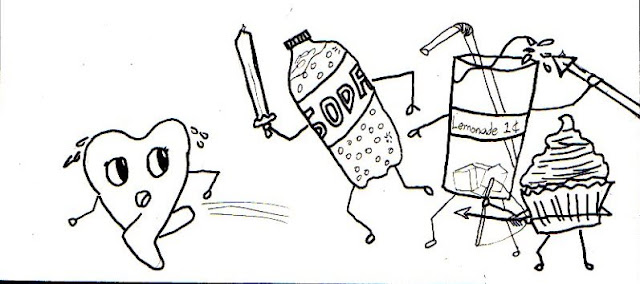 |
| By Aishwarya Jayadeep |
But having said all this, I am not sure if I could ever resist a cutie any time :-)
I thought of talking to you all about cavities, sensitivity and some foods that can contribute to that.
Tooth enamel is much like bone; a kind of lattice skeleton with minerals packed in between the lattice. (It would be easier to visualize it like a honeycomb with the honey being the minerals packed between the structure).
Many of the common food that we take can damage the enamel and trigger cavities. Anything acidic will dissolve the minerals out of the lattice structure(demineralize). Some fruit juices like apple juice are extremely acidic and contains sugars that feed harmful bacteria in the mouth. Sodas are also very acidic - this is true even for the diet ones. Fruited waters, vitamin waters,wine, pickles ,honey,sports drinks- all these are very acidic. It may come as a surprise to many that even our own saliva could turn acidic sometimes. All these can cause tooth enamel to wear away and teeth to become sensitive, cracked and discolored.
People with acidic saliva are usually those under stress, those with some kind of hormonal imbalance or anyone with a dry mouth. As we age our bodies become more acidic and this can be reflected in our saliva. When it comes to cavities, bacteria are public enemy number #1. Our mouths, teeth and toothbrushes are full of bacteria which settle on our teeth in plaque, a goo of proteins, saliva, and food debris. Bacteria devour food particles left on our teeth. Ungrateful guests, these bacteria produce acid as a by-product of their feasting. It is this acid which eats into the tooth enamel creating cavities.
However teeth have a moderate ability to repair tooth enamel by remineralizing the affected enamel with minerals from saliva. Unfortunately, in most cases the rate of destruction by acid exceeds this rate of repair.
But it is not all bad news.
Some foods may actually help defend against tooth decay in special ways. For instance, recent studies have indicated that fresh cranberries interrupt the bonding of oral bacteria before they can form damaging plaque. Other foods that have beneficial effects on oral health include:
- Calcium-fortified juices, milk and other dairy products, which are rich in calcium and vitamin D, help promote healthy teeth and bones, and reduce the risk for tooth loss
- Cheese, which unleashes a burst of calcium that mixes with plaque and sticks to the teeth, protecting them from the acid that causes decay and helping to rebuild tooth enamel on the spot
- Crisp fruits and raw vegetables like apples, carrots and celery, which help clean plaque from teeth and freshen breath
- Tannins found in coffee,cocoa and tea helps in your fight against caries ,though they stain pits and grooves of tooth enamel, producing a rough,stained surface
A diet that promotes good oral health is not just about the foods you eat or avoid — when and how you eat them is equally important.
- Foods that take a long time to chew or that you hold in your mouth (such as cough drops) can damage teeth as they hold sugar against teeth longer than do other foods
- Instead of snacking on sugary, carbohydrate-rich or acidic foods throughout the day, eat these foods just during meal times in order to minimize the amount of time the teeth are exposed to acid
great article vidhya & thanks for sharing ! loved the illustration by ur angel
ReplyDeletereally i appreciate your effort...great post with some new information..thanx Vidhay for sharing such needy information..keep up your good work...Kudos to aishu for her creative illustrations...Hugs :)
ReplyDelete